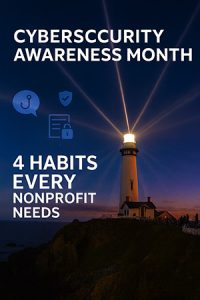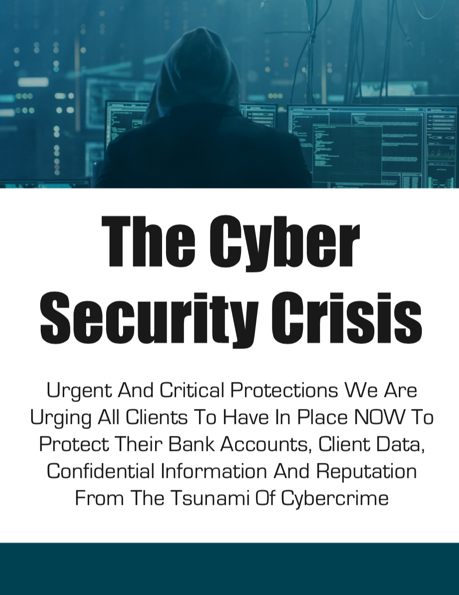 October is Cybersecurity Awareness Month — a reminder for every nonprofit leader in Metro Detroit and beyond: you don’t buy insurance after the accident. Yet too many organizations wait until after a breach to deal with the risks that could have been prevented.
October is Cybersecurity Awareness Month — a reminder for every nonprofit leader in Metro Detroit and beyond: you don’t buy insurance after the accident. Yet too many organizations wait until after a breach to deal with the risks that could have been prevented.
The reality? Most incidents don’t come from some elite hacker. They happen because of everyday habits — a staffer clicking a bad link, skipping an update, or reusing a weak password. And when they happen, they don’t just create technical headaches. They create cyber liability — risks that ripple into your donor trust, your insurance renewals, your legal obligations, and your ability to serve your mission.
The good news is that small, consistent steps can protect your nonprofit from those hidden costs. Here are four habits that reduce cyber liability and protect what you’ve built.
1. Communication: Make Cyber Risk Part of the Conversation
Cybersecurity isn’t an IT task. It’s a mission issue. That means it belongs in everyday conversations with your staff, volunteers, and even your board.
Try this:
- Open staff meetings with a quick “phish alert” — a 2-minute tip on spotting scams.
- Share news stories about breaches at other nonprofits, so your team understands what’s at stake.
- Discuss cyber risk in board meetings alongside finance and fundraising, not as an afterthought.
When communication makes security feel like second nature, your people become your first layer of defense — not your weakest link.
2. Cyber Liability: Go Beyond Checkboxes
Too many leaders think in terms of “compliance.” But cyber liability runs deeper. It’s not just about avoiding fines — it’s about the survival of your mission.
Cyber liability shows up in four dimensions:
- Business: Can you continue serving clients if systems go down?
- Legal: Are you ready for breach notification laws or HIPAA responsibilities?
- Regulatory: Do your donation and payment platforms meet PCI DSS requirements?
- Operational: How would downtime disrupt programs, volunteers, or reporting cycles?
The donors and funders who support you expect trust and stewardship. Protecting against cyber liability means proving that trust in every report, every grant application, and every renewal conversation.
3. Continuity: Build Resilience Into the Mission
If ransomware locked your systems tomorrow, how quickly could you recover? Continuity is about being ready — not hoping it won’t happen.
Every nonprofit should:
- Automate backups and test them regularly.
- Document a simple incident response plan: who calls who, how to isolate systems, how to keep funders and staff informed.
- Practice recovery steps. Even restoring a single critical donor record proves your plan works.
Continuity isn’t a technical luxury. It’s the difference between disruption and resilience when storms hit.
4. Culture: Make Cyber Awareness Part of Everyday Work
Your people are either your greatest strength or your biggest risk. Creating a cyber-smart culture means embedding protection into habits, not policies that collect dust.
Practical ways to build culture:
- Require multifactor authentication (MFA) everywhere you can.
- Use password managers instead of sticky notes or spreadsheets.
- Recognize staff who spot and report suspicious emails — make cyber wins a team celebration.
- Train your board and leadership, so stewardship is modeled from the top down.
When security is cultural, it stops being a burden. It becomes part of the DNA that protects your reputation, your funding, and your mission.
Security Is About Survival, Not Just Technology
Cybersecurity Awareness Month is a reminder: this isn’t about software, hardware, or jargon. It’s about survival. It’s about protecting what you’ve worked so hard to build — the trust of your donors, the confidence of your board, and the impact of your mission.
By building stronger habits in communication, cyber liability, continuity, and culture, you’re not just “checking compliance boxes.” You’re reducing your liability, protecting your credibility, and giving your board and funders the assurance they need.
Take the First Step — Before the Storm Hits
You don’t wait until after the accident to buy insurance. Don’t wait until after the breach to get clarity on your risks.
👉 Start with a Complimentary Risk Assessment today: https://mtsconsultinggroup.net/riskassessment
It’s not a sales pitch. It’s a simple conversation that helps you see your risks clearly, prove stewardship to your board and funders, and take action with confidence.
Because once you understand the storm, you can finally navigate it.
- Urgency without fear-mongering
- Cyber liability (business, legal, regulatory, operational) instead of compliance
- Clear connection to mission survival
- Beacon in the Cyber Storm tone
- CTA framed as safe, simple, guided



